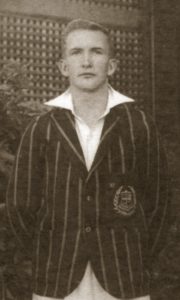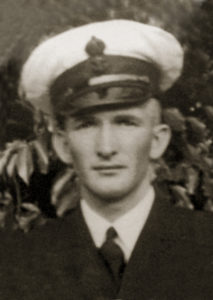- Author
- A.N. Other
- Subjects
- Biographies and personal histories, History - post WWII
- Tags
-
- RAN Ships
- HMAS Sydney II
- Publication
- March 2022 edition of the Naval Historical Review (all rights reserved)
By Darrell White ASMA
The original oil on canvas artwork Farewell Sydney was commissioned by the Western Australia Cricket Association (now WA Cricket) and made possible by a donation from the Finding Sydney Foundation in 2011. Darrel White ASMA created the artwork that formed the centrepiece of a display which included four panels: two Honour Roll panels recording the 645 personnel lost aboard HMAS Sydney II on 19 November 1941, one panel depicting the action with HSK Kormoran and a fourth panel dedicated to the memory of cricketer and naval reservist Kenneth Norman Hilton Butler. A Director of HMAS Sydney Search Pty. Ltd., CDRE Bob Trotter OAM RAN (Rtd), was a significant consultant in the process. The artwork and panels were dedicated at an unveiling ceremony at the Western Australian Cricket Association Ground on Remembrance Day 11 November 2011 to coincide with the 70th anniversary of HMAS Sydney II departing Fremantle for the last time.
Commissioned to create the moment Sydney II departed Fremantle on 11 November 1941, the Artist’s Statement records ‘the intention is to create a piece that conveys an emotional sense of what was happening the day Sydney sailed, as historically accurate as possible. With our knowledge of the events that were about to unfold, the juxtaposition of Sydney and a typical day in Fremantle creates tension in the viewer. We can also admire the ship and her company for the courage and inspiration they gave the Australian people in the early war years, becoming a symbol of strength in an increasingly turbulent time.’
The serene scene depicts Sydney departing Fremantle inner harbour looking from the North Mole. Wharfies are taking time out to do some fishing and nearby a woman and child watch the sleek lines of Sydney slip by, her crew lining the decks. It is a clear November morning and Sydney has left H wharf and is sailing to a buoy in the outer harbour, leaving behind the Fremantle port as it begins to come alive with daily activity. MS Charon, berthed alongside B Shed, takes on stores as the smoke from a steam train at Fremantle Station drifts over the neighbouring buildings. In the distance, the war memorial at Monument Hill catches the morning light and watches over the town of Fremantle as it prepares for the commemoration of Armistice Day, 11 November 1941. The Australian War Memorial in Canberra is being officially opened on the same day.
Kenneth Norman Hilton Butler: cricketer and naval reservist

One of the 645 crew aboard Sydney that day was Supply Assistant Kenneth Norman Hilton Butler, born on 22 October 1920 in Beverley, a small wheatbelt town in Western Australia, about 130 km southeast of Perth. His second and third names reflected the war service and sacrifice of his family, Norman in honour of his father’s brother and Hilton in memory of his mother’s brother, both tragically killed in WWI.
Ken Butler attended Wesley College between 1936 and 1939, becoming a prefect in 1939. Among his many sporting achievements Ken represented Wesley College in the First XI cricket team: he was also prominent in amateur drama and sang in church concerts and choral societies. In 1940 he taught lower preparatory school at Wesley College while undertaking a Teacher’s Certificate course.
Ken was a promising cricketer at an early age and was regarded as a genuine all-rounder, a batsman with a sound technique; he hit the ball hard and was able to score quickly. He was also a fine new ball bowler, proving his ability in a singular bowling performance as a 15 year-old playing for Wesley College against an Incognita cricket team, featuring three greats of English cricket, the legendary wicketkeeper/ batsman Les Ames, and two past England captains, R.E.S. (Bob) Wyatt and C.B. (Charles) Fry, all part of the England contingent in Australia during the 1936/37 Ashes summer. Ken Butler opened the bowling against Ames and Wyatt and his figure of 4/29 was an extraordinary achievement for a schoolboy. He went on to score 23 runs, hitting three fours and one six for Wesley College.
While still at school Ken played club cricket, first with Claremont-Cottesloe and later for Mt. Lawley where he debuted in the First-Grade team at 16 years and 357 days. In his first 38 matches he opened the batting on many occasions with Western Australian cricket legend Frank Bryant. His performances were noted by the Western Australian Cricket Association and in 1938 he played in a WA Colts team at the WACA Ground. At the time war was declared, Ken had the potential to play first-class cricket for Western Australia.

Joining the Naval Reserve in January 1941 he was assigned to the Supply Branch of the Royal Australian Navy, earning his rank as Supply Assistant at HMAS Cerberus in Melbourne from 30 March 1941 to 4 August 1941 when he joined Sydney. These must have been exciting days for a young man, escorting convoys of huge troopships sailing first from Sydney to Auckland, then to Suva, back to Sydney, and then Melbourne, and across the Great Australian Bight to Fremantle. Little did they know that when sailing from Fremantle on that bright sunny morning on 11 November 1941 that this would be their farewell mission. Eight days later while returning on a routine west coast patrol they intercepted an innocent looking merchant ship which turned out to be the heavily disguised German warship HSK Kormoran. In the subsequent engagement both ships fought to the death with all aboard Sydney paying the ultimate sacrifice in this our nation’s worst maritime tragedy. Ken Butler had just turned 21 and was amongst the 645 brave men who lost their lives when Sydney was sunk on 19 November 1941.
In November 2021 the artwork Farewell Sydney and panels were lent to the Western Australian Maritime Museum on Victoria Quay, Fremantle where they will be displayed while the Western Australian Cricket Association Ground is refurbished, and a new display space created for Farewell Sydney.
LEST WE FORGET




